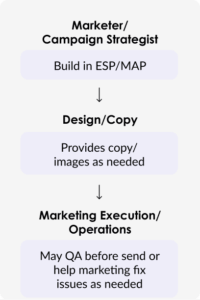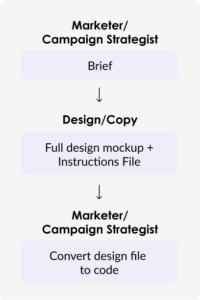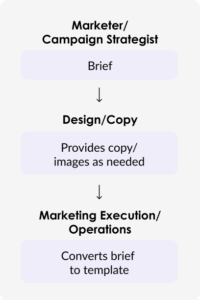A quiet but profound shift is happening in marketing: marketing operations leaders are stepping out of the shadows of execution and into the spotlight as architects of how work gets done. Their new mandate? Redesign workflows, eliminate inefficiencies, and empower teams to scale campaign production without compromising governance or speed, all while still delivering on performance and strategy.
At the heart of this transformation is the Creation Operating Model. And for good reason: The way content is created now has as much impact on outcomes as the content itself.
Bottlenecks to blueprints
Campaign creation was once a tactical chore. Email and landing page production were siloed, slow, and overly dependent on technical specialists like developers and coders. Marketing ops teams focused on delivery logistics, ensuring assets made it to deployment platforms on time, often through sheer willpower and duct tape solutions.
But the playbook has changed. Campaign velocity is now a competitive advantage, and with AI leading creation, teams are creating faster than ever. And yet, bottlenecks still occur.
What’s more, operational leaders are being asked to do more than keep workflow trains running. They’re being asked to reimagine the tracks.
Whether you’re overseeing global demand gen or managing dozens of business units with distinct branding needs, your challenge isn’t just how much content you produce. It’s how you produce it, and whether that process is a competitive advantage asset or a liability.
An optimized Creation Operating Model, the hidden lever for performance
A Creation Operating Model is the workflow infrastructure behind every marketing asset. It governs who creates, how they create, and what rules guide creation. Most enterprises operate within one of three outdated models:
- Distributed: Marketers are fighting with templates and hoping the output doesn’t break.

- Design-to-Code: Creative teams pass specs to developers, introducing delays and dependencies—and often issues in translating creative to production.

- Brief-to-Template: Ops teams paste briefs into rigid templates, adding friction and reducing flexibility.

None of these models are truly built for the AI era, where content demand has exploded and marketing agility is non-negotiable.
The result? Bottlenecks at every turn. Delays in campaign launches. Broken brand compliance. Over-reliance on developers. And wasted time that could be spent on strategy.
Marketing operations leaders are now expected to fix that. Not by swapping in new tools, but by rethinking the model itself.
Ops is perfectly positioned to lead the change
Ops leaders are uniquely suited to become workflow architects. Here’s why:
- They own the map: Ops understands the end-to-end process—who’s involved, where things stall, and what’s costing time or money.
- They see the risk: From compliance issues to brand inconsistencies, ops leaders live in the tension between speed and control.
- They’re already optimizing: Whether it’s MarTech stack management or process documentation, ops is built to refine systems.
The value of having an ops leader at the helm of owning and transforming their team’s Creation Operating Model becomes clear. They can redesign workflows with guardrails in place not just for compliance, but as enablers of agility.
Navigating the shift from execution to enablement
This isn’t about replacing humans with automation. It’s about enabling people to do their best work. In modern creation models:
- Marketers don’t wait for developers.
- Designers aren’t caught in endless revisions.
- Compliance is embedded, not enforced after the fact.
- Campaigns launch in days—not weeks.

Ops leaders drive this shift by embedding no-code tools, smart governance, and built-in QA directly into the process. They move their teams from tactical production to strategic execution—and they do it with fewer bottlenecks and broader collaboration.
Timing is everything, and the time is now
AI is accelerating content demand, not reducing it. Campaign volume is up. Brand expectations are higher. And marketing teams can’t afford to rely on outdated creation processes.
For marketing leaders and decision makers, this means ballooning costs, missed revenue opportunities, and eroded ROI. For the individual marketers, it means daily firefighting and constant triage.
The solution is a new Creation Operating Model—one designed for scale, speed, and safety.
The new mandate: architect the future
Ops leaders are the architects of how marketing performs. They decide whether creativity flows or fizzles out. Whether teams execute strategy—or a broken Creation Operating Model buries it in bottlenecks.
It’s time to elevate the creation operating model from afterthought to strategic priority.
Want to take the next step?


